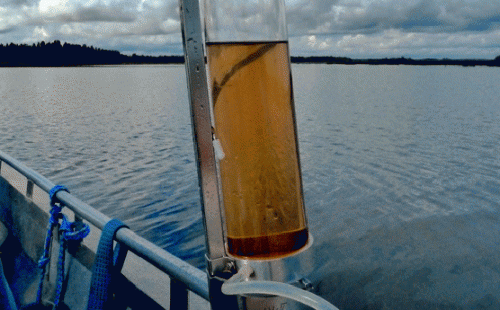Transformation and flocculation of riverine organic matter in estuaries

Microbes and the salt in sea water significantly shape organic matter transported by rivers to their estuaries, clarifies researcher Eero Asmala in his doctoral thesis at the Finnish Environment Institute. In his study, Asmala investigated changes in riverine dissolved organic matter in the Baltic Sea's estuaries.
"The study found significant flocculation of organic matter even at very low salinities at the mouth of the river. This is likely to affect the bottom sediment and biota, as a considerable proportion of the riverine organic load ends up in a relatively narrow zone along the coast," Eero Asmala says.
Flocculation was found to be selective. It changes the composition of organic matter en route from land to sea, removing humic compounds and reducing average molecular size, among other things.
The material in the doctoral research study consisted of field and laboratory data. The changes in riverine organic matter in estuaries were investigated by means of various chemical and biological analyses. The results of the study refine the picture of the estuarine carbon and nutrient cycle as well as strengthen the link between land-use and the status of Finland's coastal waters.
A million tonnes of different compounds
The cycle of organic matter in estuaries is not understood well, even though the nonpoint source pollution carried from the riverine catchment is one of the main causes of eutrophication of the Baltic Sea. Finnish rivers discharge approximately one million tonnes of organic carbon into the Baltic annually. The majority of this carbon is in a dissolved form distinguishing it from the particulate form, in other words, the individual molecules are less than a micrometre in size.
"Dissolved organic matter (DOM) consists of thousands of different compounds whose properties vary widely. Some DOM is more and some is less readily available for the microbial food web such as bacteria and algae. In addition to carbon, DOM also contains other elements such as nitrogen and phosphorus, which are active in marine eutrophication," Asmala explains.
Variation between rivers and seasons, impact of land-use In his study, Asmala found considerable variation in the properties of riverine organic matter between rivers and seasons. He assessed the characteristics by means of chemical analyses. The availability of organic matter for microbial decomposers in estuaries was studied using microbiological methods.
"The study shows that land-use affects the coastal food chain. How much and what kind of organic matter ends up in the food web? Organic matter originating from agricultural land is easier for microbes to degrade than that originating from forest and peatlands," Asmala points out.
With climate change, winters are expected to be milder and wetter in the future, which in turn will increase organic matter loading in coastal waters. The results of this study will help to assess how the status of coastal waters in a changing environment can be improved by adjusting land use. Measures to reduce organic load are very similar to actions designed to prevent conventional inorganic nutrients, nitrogen and phosphorus from getting into waterways.
Mr Asmala's dissertation is entitled "Transformation and removal of riverine dissolved organic matter in Baltic Sea estuaries." His dissertation was publically examined on 7 March at the University of Helsinki. Professor Stiig Markager from Aarhus University, Denmark, served as the opponent.
More information: Eero Asmala's doctoral dissertation is available online: helda.helsinki.fi/handle/10138/42845
Provided by Finnish Environment Institute (SYKE)


















